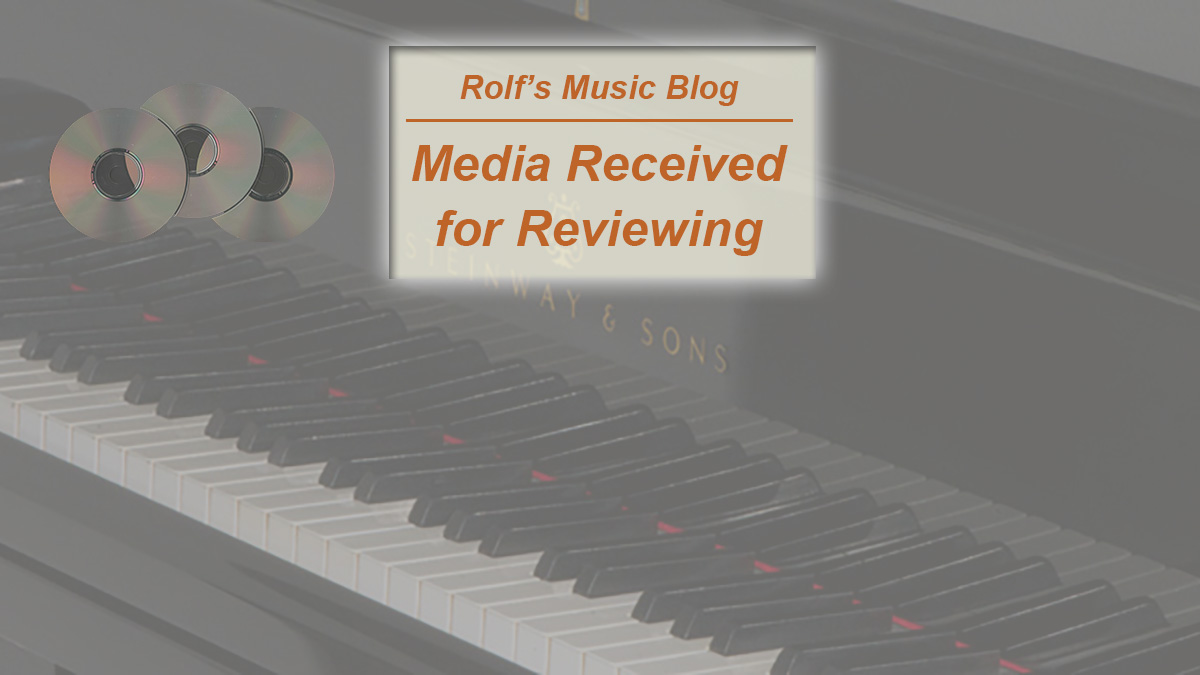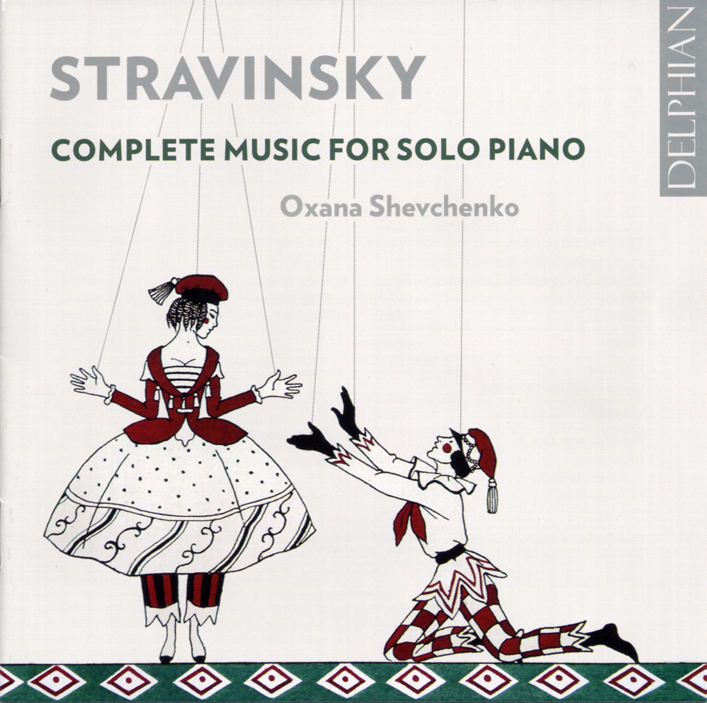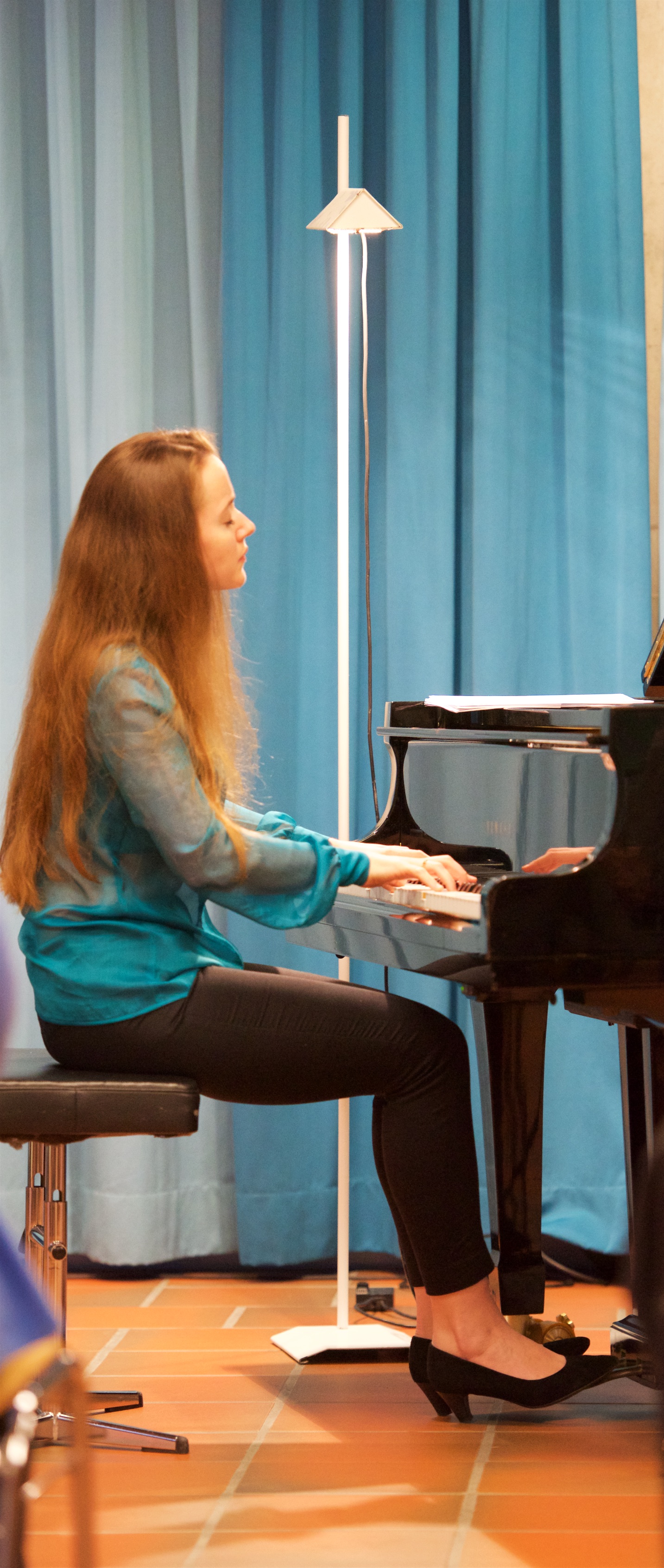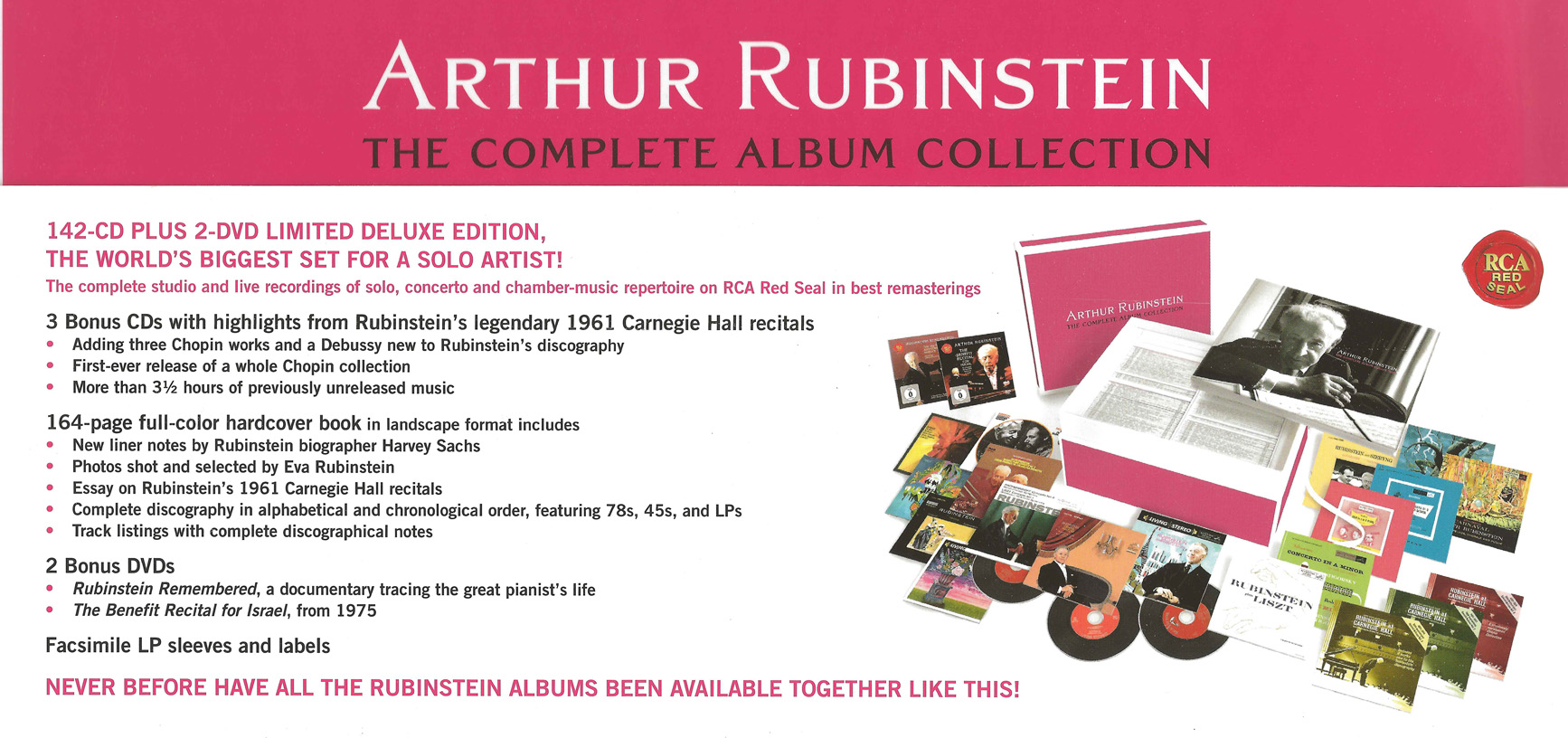Oxana Shevchenko
Stravinsky: Complete Works for Solo Piano
Media Received for Reviewing

2019-01-02 — Original posting
Table of Contents
- Introduction
- The CD
- Oxana Shevchenko’s Performance
- Comments on the Pieces / Compositions
- Scherzo (1902)
- Sonata in F♯ minor (1904)
- Quatre Études , op.7 (1908)
- Ballet “The Firebird” (1910, excerpts)
- Ballet ” Pétrouchka ” (1911, excerpts)
- Souvenir d’une marche boche (1915)
- Valse pour les enfants (1917)
- Ragtime for 11 Instruments (1918)
- Piano-Rag-Music (1919)
- Fragment des Symphonies pour instruments à vent à la mémoire de Claude Achille Debussy (1920)
- Les cinq doigts (1921)
- Sonata (1924)
- Serenade in A (1925)
- Tango (1940)
- Circus Polka (1942)
- Conclusions
- Interactive Track Listing for the Stravinsky CD Set
- Other / Related CDs
Introduction
I do not need to introduce the Kazakh pianist Oxana Shevchenko (born 1987 in Almaty): my first concert encounter with Oxana goes back to 2015-08-27—see my concert review for details on the artist’s bio. I have since had the opportunity and the pleasure to experience that artist in concert on around 15 occasions (5 solo recitals, 7 duo recitals, 3 concerts with orchestra), all but one of these are documented in blog postings.
Oxana Shevchenko’s debut solo CD included works by Ravel, Shostakovich, Liszt, Mozart, and Thea Musgrave, see below for a reference.
Stravinsky Preparations & Recording
Oxana has had music for piano solo by Igor Fyodorovich Stravinsky (1882 – 1971) in her repertoire for years already. I heard her perform the Three Movements from “Petrushka” (Trois movements de “Pétrouchka”, see below) already at a private recital on 2016-01-16. One year later, in January/February 2017, I had the pleasure of helping Oxana with a short series of local “trial recitals” in preparation for this recording (Rüti ZH 2017-02-01; Uster ZH 2017-02-02; Zürich 2017-02-03; and finally Weinfelden TG 2017-02-05). In these “trial recitals”, Oxana Shevchenko performed almost all of the pieces on the CD set presented here.
The actual recording took place the following month, on 2016-03-06 up to 2016-03-08 in the Collegiate Church of St.Mary the Virgin in Haddington, East Lothian (EH41, some 25 km East of Edinburgh). The instrument in the recording was a Steinway model D-274 concert grand. Since May 2018, the recording is now available from Delphian, Ltd. (a recording company / label located in Edinburgh, U.K.):
The CD
Stravinsky: Complete Music for Solo Piano
Oxana Shevchenko
Delphian DCD34203 (2 CDs, stereo); ℗ / © 2018; Booklet: 12 pp. English
What’s in the Recording?
The above CD set includes 15 (10 + 5) compositions on a total of 37 (24 + 13) tracks, all for piano solo, 2 hands. Stravinsky has also composed a few works for piano, 4-hands, as well as for two pianos. In addition, Stravinsky composed or arranged a series of works for player piano. Apart from the Three Movements from “Pétrouchka“, Stravinsky also created piano scores from two ballet compositions (“The Firebird”, 1910, and Apollon musagète, 1928)—however, these were not meant for the solo repertoire, but merely served as scores for ballet rehearsals.
After some general comments on the recording, I’m presenting the compositions in chronological order (i.e., not how they appear on the CDs):
- Scherzo (1902)
- Sonata in F♯ minor (1904)
- Quatre Études, op.7 (1908)
- Ballet “The Firebird” (1910, transcription, excerpts)
- Trois Mouvements de “Pétrouchka” (transcription, 1921)
- Souvenir d’une marche boche (1915)
- Valse pour les enfants (1917)
- Ragtime for 11 Instruments (1918, transcription)
- Piano-Rag-Music (1919)
- Fragment des Symphonies pour instruments à vent à la mémoire de Claude Achille Debussy (1920)
- Les cinq doigts (1921)
- Sonata (1924)
- Serenade in A (1925)
- Tango (1940)
- Circus Polka, composed for a young elephant (1942)
Specific comments are added to the relevant sections, where applicable. For an overview of the tracks & pieces on the CD set see the interactive list towards the bottom.
Oxana Shevchenko’s Performance
I hadn’t been attending so many of her recitals & public appearances if I wasn’t fascinated by this artist—and I had no doubt whatsoever that her Stravinsky recording would not disappoint me. And needless to say: it didn’t!
My first encounter with this artist (via YouTube) was with a classical sonata. However, her subsequent concert performances 2015/2016 showed me her real strengths. First and foremost, these lay in the highly virtuosic and expressive romantic, late-romantic and post-romantic repertoire, where composers such as Johannes Brahms (1833 – 1897), Franz Liszt (1811 – 1886), Frédéric Chopin (1810 – 1849), Pyotr Ilyich Tchaikovsky (1840 – 1893), Sergei Prokofiev (1891 – 1953), Nikolai Medtner (1880 – 1951), Maurice Ravel (1875 — 1937), Enrique Granados (1867 – 1916), and of course Igor Stravinsky must be among her favorites.
Specific Strengths
The aspects of her playing that I admire the most go far beyond technical prowess:
- her ability to connect with the audience (which of course includes aspects of her personality)
- the way in which she lives in and with the music that she is performing. On rare occasions, people made critical remarks about her “showing what the listener is meant to feel”. This would imply that her facial mimics, her gestures are “made up”—there is no doubt in my mind that these motions / emotions are genuine. And, indeed…
- Oxana’s performances are never “dead”, formal, or “cold perfection”: rather, the music lives with and through her. Hence, her performances remain authentic.
- In the area of high virtuosity and drama, her physical strength and power reserves are most astounding.
- At the same time, in lyrical, emotional, expressive music, her playing can be exceptionally touching, moving. Stravinsky may rarely be a good opportunity for this, but some of her chamber music performances are among the very best that I have ever heard.
- I stated that Oxana’ particular strength is in highly virtuosic and expressive music. That by no means implies that she would neglect the simpler, easier pieces in this collection. I met her as a very sensible, conscientious, careful musician. Therefore, nothing here is casual, not even the almost trivial pieces that Stravinsky wrote for children’s hands.
Comments on the Pieces / Compositions
I have not added comments on Oxana Shevchenko’s performance to each and every track / movement / composition. I wanted to avoid an excess of repetition. Especially for the lesser known compositions I’m focusing on presenting my listening impression, rather than Oxana’s performance. For general comments on Oxana’s playing see above and the “Conclusions, General Comments on Performance & Recording” section below.
Scherzo (1902)
This is also referred to as Scherzo in G minor. It is one of Stravinsky’s first compositions altogether, composed at age 20: Wikipedia lists one composition for voice and piano from the same year, Le Nuage (Туча; The Storm Cloud). Actually there was one earlier composition for piano, a Tarantella, from 1898—a student work which the composer wrote in St.Petersburg, not intended for publication—and consequently not included here.
The Scherzo forms a somewhat harmless beginning. On could hardly say that it is typical of Stravinsky. The main attraction of having this and the Sonata in F♯ minor in the collection is that these early compositions give a rare glimpse onto how Stravinsky grew into his personal style.
How does it sound?
This piece comes in ternary form, with Scherzo-like outer parts (vivo). Even though the composer hadn’t found his style yet, one can sense his personality in the somewhat capricious flow in the vivo part, the moody atmosphere. Stravinsky refuses to fall into “naturally breathing phrases”, or to follow a persistent rhythmic scheme / pattern. This vivo part has two repeated sections, 8 + 18 bars, whereby the first 8 bars (G minor) split into two almost identical groups of 4 bars, and these are also found at the end of the 18-bar period, which begins in B♭ major—a “friendlier”, more serene version of the first theme. The second instance of the Scherzo (Tempo primo) has not repeated and expands the structure to 43 bars, through a coda.
The central Trio (moderato) part, more lyrical, gentle, flowing, melodic—also more conventional, though, with a repeated first part. The ending of the initial 4-bar period (at the repeat sign) feels slightly odd, as if it missed a beat or a bar. That’s not the pianist’s fault, but (I think) rather reflects the sketchy nature of the composition. Or maybe it is a sign of the composer’s inner fight with conventional schemes?
Sonata in F♯ minor (1904)
Two years later, Stravinsky wrote his biggest, genuine composition for piano solo, the Sonata in F♯ minor, lasting almost 30 minutes. The work follows the traditional scheme, with four movements:
- Allegro
- Scherzo: Vivo
- Andante
- Finale. Allegro – Andante
This early sonata is rarely heard in concert (or in recordings): it is far less sketchy than the Scherzo, but a much more accomplished composition. However, the composer was still seeking his personal style, was not yet in a position to detach himself from the musical environment in which he grew up.
I. Allegro
The first movement starts with a grandiose gesture. It’s an excellent start, if not the stroke of a genius, even though it bears resemblances to piano works by Tchaikovsky, maybe also Nikolai Medtner, Sergei Rachmaninoff (1873 – 1943) and other Russian composers. That inspiration didn’t last too long, though. A sweetish, cadenza-like transition leads to a second theme. This is lyrical, harmonious in its melody, and in some way a concoction of Tchaikovsky and operetta style, momentarily even trivial, simplistic. Luckily, that impression only occurs at the presentation of the second theme, and shortly in the recapitulation, towards the end. Otherwise, the movement is highly pianistic, virtuosic—it’s for good reason that I mentioned Rachmaninoff and Medtner: overall, I really like this music!
Oxana Shevchenko’s performance hides the technical challenges in this big movement.
II. Scherzo: Vivo
In its attitude, this movement could just as well be by Tchaikovsky—though harmonically, one can sense a scent of Nikolai Medtner. Unlike a traditional Scherzo, it is mostly in 2/4 time—though there is a lyrical Trio-like central part in 3/4 time (greetings from Tchaikovsky’s “The Seasons”, op.37a!).
Excellent playing, clear, light articulation, transparent, playful!
III. Andante —
A gentle, harmoniously flowing movement—and again very, very close to Tchaikovsky’s “The Seasons”: true, not “Stravinsky as we know him otherwise”—but beautiful, romantic music anyway!
IV. Finale. Allegro – Andante
The final movement follows attacca; it picks up the rhythmic pattern from the Andante. The transition is natural, seamless—and yet instantly recognizable by the jubilant theme. The melodic component is somewhat trivial. The music does also remind of Tchaikovsky’s “The Seasons”, keeping the “Russian spirit”, even though some textures appear derived from late classical piano music.
Oxana’s plying is delightful, brilliant, and as careful as everywhere else on these CDs—musically, though, the Finale seems not to be quite at the level of the first three movements.
Quatre Études, op.7 (1908)
The Études (studies) don’t mean to exhibit musically challenging, complex structures: they are all between 1.5 and 3 minutes only. Rather, the focus is on technical aspects of piano playing—and some of these studies are indeed pianistically demanding!
- Con moto
- Allegro brillante
- Andantino
- Vivo
The four years between the early sonata and these studies also led to substantial progress in Stravinsky’s prowess as composer and pianist. Here, the music reminds me of Sergei Rachmaninoff’s piano textures, much more than Tchaikovsky’s. The main, technical focus of these studies is on rhythmic independence of the two hands:
I. Con moto
There is an almost constant chain of quintuplets running through, mostly in the left hand (“spiced up” with three septuplets), as accompaniment to the other hand playing mostly triplets, or triplets plus duplets. This seems complicated to a lay listener—Oxana Shevchenko makes this sound entirely natural. The listener is not meant to follow the individual lines. Rather Stravinsky wanted to create a complex rhythmic pattern / structure, which Oxana Shevchenko forms to an impressive dramatic arch.
II. Allegro brillante
The right hand has a tricky pattern of 2 x 3 x 2 semiquavers (6/8 time), while starting in bar #4, the left hand plays a wide-spanning chain of staccato semiquaver quadruplets (with occasional quintuplets). The effect is mind-boggling—in a way, it reminds me of some of the 53 Studies on Chopin’s Études by Leopold Godowsky (1870 – 1938): specifically, the last two, where Godowsky merges two of Chopin’s studies into one. Here, it would perhaps rather be a Prélude plus an Étude? Brilliant, indeed—both the composition, as well as Oxana Shevchenko’s playing!
III. Andantino
A light semiquaver chain (6+6, 6/8 time) in the descant, as accompaniment to a quaver melody in the middle, whereby the left also plays a slow, calm chain of intervals/chords, defining harmony and rhythm. It’s a beautiful, serene Nocturne—short, just 95 seconds, but technically far more intricate than it seems! I like the subtle agogics, and the gentle, broad dynamic arch over the entire piece in this performance.
IV. Vivo
Another, brilliant study, fast, busy—as busy in the semiquaver pattern as some pieces by Felix Mendelssohn Bartholdy (1809 – 1847), just technically much trickier! The accompaniment is alternating between light, inconspicuous staccato quavers, jumping chords, and the occasional menacing, ascending chromatic scale in the bass: an utterly fascinating piece! Towards the end of the middle section, Oxana relaxes the pace very slightly—that’s not a loss in tension, though, rather deliberate: with the return to F♯ major, the initial tempo and theme return all the more effectively. Excellent!
In some ways (not just in the sparkling ending!), this Étude reminds me of No.6, Étincelles from Huit Morceaux Charactéristiques, op.36 by Moritz Moszkowski (1854 – 1925), one of the favorite encores of Vladimir Horowitz (1903 – 1989). Musically, though, I think that Stravinsky’s Étude offers much more than Moszkowski’s “Sparks”.
Ballet “The Firebird” (1910, excerpts)
It would be nice to have the composer’s piano transcript of the famous, first ballet “The Firebird”! Stravinsky did create a complete piano excerpt—though that’s a mere skeleton, designed for the accompanist in ballet rehearsals. It was never meant to be performed in concert. However, in 1963, the Italian pianist Guido Agosti (1901 – 1989) arranged excerpts for piano, and Oxana Shevchenko included this in her recording: it absolutely makes sense to have this famous landmark among Stravinsky’s ballet compositions included in this collection! The three movements in Agosti’s brilliant transcription are
- Infernal Dance of King Kastchei
- Lullaby
- Finale
Performance Notes
The opening movement is an immense technical / virtuosic challenge, and at the same time a fascinating kaleidoscope of characters, images and moods, strenuous, power-draining, and a true firework! Oxana Shevchenko’s playing, her technical abilities, and her power are truly amazing! Around the middle, there is a very slight loss in tension. However, this is unique throughout the entire collection and does not affect the (my) overall impression—it is one of very, very few and minor quibbles that I have throughout these two hours of music!
The second movement is very calm, serene, very atmospheric—and it flows over into the splendid final movement, where Oxana can deploy the full sonority of the Steinway, to spread out a grandiose soundscape: fascinating!
Ballet “Pétrouchka” (1911, excerpts)
In 1921 Arthur Rubinstein (1887 – 1982) met Stravinsky and suggested creating a piano score from parts of this popular ballet. Stravinsky did pick up on this suggestion and created the Trois Mouvements de “Pétrouchka”, which he dedicated to Arthur Rubinstein. The three movements are
- Russian Dance (Danse Russe: Allegro giusto)
- Petrushka’s Room (Chez Pétrouchka)
- The Shrovetide Fair (La Semaine Grasse: Con moto – Allegretto – Tempo giusto – Agitato)
Performance Notes
I have written about earlier performances of the Trois Mouvements de “Pétrouchka” by Oxana Shevchenko (private recital, 2016-01-16, and in Uster, 2017-02-02) and have very little, if anything to add to these reports: this composition has been in her repertoire for several years: to say that she is mastering these movements well would be an understatement. I do have two additions, though. For one, in the recording (almost certainly not the performance), the beginning of the third movement seems somewhat soft, as if the recording engineer was fading in for a fraction of a second. Most other recordings start f (if not ff) at this point. That’s really just a minor quibble (the hair in the soup!). Then, I want to refer to two other recordings of the Trois Mouvements de “Pétrouchka”, and to an earlier comparison of mine:
Relating Oxana Shevchenko’s Performance to Others
In an earlier posting, on 2014-05-07, I have done a comparison of the two other recordings in my CD collection, listed at the bottom of this posting. That short comparison included a few performances that I watched via YouTube. I don’t have the intent to re-do this by including Oxana Shevchenko’s recording. However, I want to add just a few, generic comments on how Oxana’s performance (roughly) compares to that of Arthur Rubinstein (1961) and the performance in the 1971 debut recording by Maurizio Pollini (1942 – 2024):
- Rubinstein not only plays a different version of the score, but he also can’t compete with either Pollini nor Oxana Shevchenko, nor most other, recent recordings by other artists. I think that in his live performance in 1961, his technical abilities were already on a decline. I would have to rate this ★★/★★★/★★★ (for the three movements, respectively) by today’s measures.
- Pollini, on the other hand, at age 29, was at the peak of his technical abilities—his performance is technically brilliant, flawless, if not virtually perfect. At the time of my comparison, I would have given him a ★★★★★ rating. And if someone is looking for a perfect performance, then he still deserves that rating.
Pollini’s performance is not only near-perfect, his tempo is typically faster, his articulation often swifter than Oxana Shevchenko’s. However, the latter to me conveys more life, more emotions, more expression, is more imaginative. Perfection is not Oxana’s prime objective—rather, she wants to bring this music to life. And she is very successful at that. To me, she now deserves the ★★★★★ rating, while I would degrade Pollini’s to ★★★★. That’s just my personal opinion, as usual…
Souvenir d’une marche boche (1915)
Les boches—that’s what the French sometimes call the Germans. Certainly at war times, this had a negative connotation. Stravinsky composed the short Souvenir d’une marche boche (Souvenir of a German March) for a gift book, in the context of a fundraising for Belgian war orphans. It’s mostly an anti-German caricature, though. Still, it’s a short, entertaining fun piece, with an even shorter Trio section in the middle.
In the last bars, there is a string twanging momentarily. I’m sure that leaving this in the recording was deliberate—it’s not a defect, but in the spirit of the piece. It does not affect the listening experience at all.
Valse pour les enfants (1917)
A similarly casual, short piece, originally improvised in the offices of Le Figaro, “for its young readers”. Small, harmless, but still a tiny gem…
Ragtime for 11 Instruments (1918)
The Ragtime started as a composition for 11 instruments. Stravinsky created a reduction for piano: a typical ragtime, spiced up with “casual dissonances” and harmonic shifts, a multi-faceted sequence of images / sceneries: fun, for sure!
Piano-Rag-Music (1919)
The Ragtime, in a way, is a neo-classical composition, in that it imitates Jazz style, merely spices it up. The Piano-Rag-Music, just one year later, is far more “modernist”, rebelling, wild, eruptive, anticipating Stravinsky’s style in his piano compositions from the mid-20s. One can feel how much fun Oxana Shevchenko has in playing this: enthralling, fascinating!
Fragment des Symphonies pour instruments à vent à la mémoire de Claude Achille Debussy (1920)
Stravinsky wrote the “Symphonies of Wind Instruments”, the Symphonies pour instruments à vent à la mémoire de Claude Achille Debussy, in 1920, in Memory of Claude Debussy (1862 – 1918). The piece of 9 minutes premiered in London, in 1921. The “Fragment” is a reduction of the final chorale of that piece for piano. Stravinsky originally published the chorale in the magazine La Revue musicale in an edition entitled Le Tombeau de Claude Debussy, which included short pieces from several composers, dedicated to Debussy’s memory.
A solemn, calm, pensive, strictly homophonic piece, creating a “hollow”, mourning (mysterious?) atmosphere with “painful dissonances”. Beautiful in its own way, certainly touching!
Les cinq doigts (1921)
The subtitle is 8 mélodies très faciles sur 5 notes (“8 very easy melodies on 5 notes”): the right hand typically just plays 5 notes and does not need to move on the keyboard. The tempo annotations are as follows:
- Andantino
- Allegro
- Allegretto
- Larghetto
- Moderato
- Lento
- Vivo
- Pesante
These pieces are used in piano lessons. The “very easy” may be true—though, these aren’t necessarily just pieces for kids: Oxana Shevchenko plays them faster than typical children’s performances, and of course fluent, with suitable agogics and dynamics, full of drive, life and momentum the faster ones. And she devotes as much care and attention to detail as in the challenging, virtuosic pieces, such as the Sonata and the Serenade:
Sonata (1924)
The Sonata (Sonate pour piano), along with the Serenade, is one of the highlights of Stravinsky’s neo-classical period:
- ♩ = 112
- Adagietto
- ♩ = 112
There is plenty of baroque heritage in the outer movements: enthralling, lively, virtuosic, enthralling. In the Adagietto, the composer mentioned influences by Beethoven. All of the movements are truly beautiful music, masterworks, and easily accessible. As expected, Oxana’s performance is excellent. In the first movement, I particularly like the contrast between the staccato accompaniment—relentless, yet leaving space for agogics in the embedded, melodious legato cantilena.
The middle movement features a highly ornamented melody line above a calm, stepping, staccato accompaniment. Oxana’s interpretation is beautiful—my only reservation, maybe: the flow of the melody is very natural, eloquent, but in the accompaniment, there is occasionally a tiny bit of unrest. My personal preference would be for the stepping accompaniment to be more persistent, reserving the agogics to the melody line (but who am I to criticize a pianist in this music?).
The last movement: agile, swift, light, transparent, virtuosic, full of drive, enthralling—fascinating!
Serenade in A (1925)
The Serenade in A followed one year after the Sonata. As the Wikipedia article notes, “A” is not the tonality in a conventional sense, but merely the tone around which the composition circles and evolves. The Serenade consists four short movements:
- Hymn
- Romanza
- Rondoletto
- Cadenza finala
As the Sonata, the Serenade is a highlight in Stravinsky’s neo-classical period: there are many influences / pattern from classical and baroque music. However, what one might expect as typical “serenade atmosphere” exists momentarily in the Romanza only. There are also close resemblances to the Sonata, especially in the fast segments. In general, compared to the Sonata, the atmosphere is more serene, lucid, if not pure joy. As a composition, I have a hard time telling whether I prefer it over the sonata—simply put: both are equally beautiful music, even highlights among the piano music of the (early) 20th century. And, of course, they are the highlights & favorites on these CDs!
Tango (1940)
This is Stravinsky’s last, genuine piano composition, and apparently one of the most popular ones. The composer wrote it after settling in California—even though deviating from the regular scheme, it still is easily recognizable as a Tango, entirely tonal (D minor, D major in the central part), rhythmically strict and consequential, easily accessible to any listener, despite the few (moderate) dissonances: short and catchy!
Circus Polka (1942)
The Circus polka originally is an orchestral composition. Stravinsky wrote it for a ballet production that the choreographer George Balanchine (1904 – 1983) did for Ringling Bros. and Barnum & Bailey Circus. The ballet was performed by fifty elephants and fifty ballerinas. Allegedly, in a phone conversation with Balanchine, Stravinsky only agreed to writing this if the elephants were very young. It’s a light-hearted piece; entertainment music, obviously—but serious fun, no doubt! The piano transcription bears the title “Circus Polka, composed for a young elephant“, in reference to the phone conversation with Balanchine.
Oxana Shevchenko clearly had fun performing this: that transpires through every single note! I definitely like the performance, independent of its original purpose. If I think of young (or old) elephants dancing to this music, I could easily picture more clumsy, more caricature-like performances—but this is not meant to be criticism, by any means! I merely want to say that other views may be possible here.
Conclusions
Ignore the sparse quibbles in my comments: they are absolutely negligible. I can wholeheartedly say: this CD set is worth a strong recommendation! In the course of writing this posting, I have listened to all tracks numerous times, and I never fell tired of any single piece!
Interactive Track Listing for the Stravinsky CD Set
The track listing below is interactive, i.e., you can sort the list by any column, ascending or descending, just by clicking on a header field. The “Year” column is the year of the original composition, not (in the case of arrangements) the year in which a piano version / arrangement was created. The initial sorting is chronological (ascending in column #2. To see the list in which the tracks appear in the order of the CD set, click on the header of column #1.
| Track# | Year | Title | Duration |
|---|---|---|---|
| 1-24 | 1902 | Scherzo | 02'20" |
| 2-05 | 1904 | Sonata in F♯ minor: 1. Allegro | 11'10" |
| 2-06 | 1904 | Sonata in F♯ minor: 2. Vivo | 04'54" |
| 2-07 | 1904 | Sonata in F♯ minor: 3. Andante | 06'12" |
| 2-08 | 1904 | Sonata in F♯ minor: 4. Allegro | 06'33" |
| 1-07 | 1908 | Quatre Études, op.7: 1. Con moto | 01'39" |
| 1-08 | 1908 | Quatre Études, op.7: 2. Allegro brillante | 02'43" |
| 1-09 | 1908 | Quatre Études, op.7: 3. Andantino | 01'35" |
| 1-10 | 1908 | Quatre Études, op.7: 4. Vivo | 02'07" |
| 1-01 | 1910 | Ballet "The Firebird" (arr. Guido Agosti, 1963): 1. Infernal Dance of King Kashchei | 05'16" |
| 1-02 | 1910 | Ballet "The Firebird" (arr. Guido Agosti, 1963): 2. Lullaby | 03'17" |
| 1-03 | 1910 | Ballet "The Firebird" (arr. Guido Agosti, 1963): 3. Finale | 03'47" |
| 2-01 | 1911 | Trois mouvements de "Pétrouchka" (arr. Stravinsky, 1921): 1. Danse Russe: Allegro giusto | 02'43" |
| 2-02 | 1911 | Trois mouvements de "Pétrouchka" (arr. Stravinsky, 1921): 2. Chez Pétrouchka | 04'30" |
| 2-03 | 1911 | Trois mouvements de "Pétrouchka" (arr. Stravinsky, 1921): 3. La Semaine Grasse: Con moto - Allegretto - Tempo giusto - Agitato | 09'02" |
| 2-04 | 1915 | Souvenir d'une marche boche | 01'49" |
| 1-06 | 1917 | Valse pour les enfants | 01'01" |
| 1-05 | 1918 | Ragtime for 11 instruments (arr. Stravinsky) | 04'48" |
| 1-20 | 1919 | Piano-Rag-Music | 03'16" |
| 2-09 | 1920 | Fragment des Symphonies pour instruments à vent à la mémoire de Claude Achille Debussy | 02'30" |
| 1-12 | 1921 | Les cinq doigts, 8 pièces faciles sur cinq notes: 1. Andantino | 00'35" |
| 1-13 | 1921 | Les cinq doigts, 8 pièces faciles sur cinq notes: 2. Allegro | 01'05" |
| 1-14 | 1921 | Les cinq doigts, 8 pièces faciles sur cinq notes: 3. Allegretto | 00'47" |
| 1-15 | 1921 | Les cinq doigts, 8 pièces faciles sur cinq notes: 4. Larghetto | 01'10" |
| 1-16 | 1921 | Les cinq doigts, 8 pièces faciles sur cinq notes: 5. Moderato | 00'43" |
| 1-17 | 1921 | Les cinq doigts, 8 pièces faciles sur cinq notes: 6. Lento | 00'46" |
| 1-18 | 1921 | Les cinq doigts, 8 pièces faciles sur cinq notes: 7. Vivo | 00'28" |
| 1-19 | 1921 | Les cinq doigts, 8 pièces faciles sur cinq notes: 8. Pesante | 01'04" |
| 1-21 | 1924 | Sonata: 1. — | 02'55" |
| 1-22 | 1924 | Sonata: 2. Adagietto | 05'23" |
| 1-23 | 1924 | Sonata: 3. — | 02'41" |
| 2-10 | 1925 | Serenade in A: 1. Hymn | 02'53" |
| 2-11 | 1925 | Serenade in A: 2. Romanza | 02'46" |
| 2-12 | 1925 | Serenade in A: 3. Rondoletto | 02'21" |
| 2-13 | 1925 | Serenade in A: 4. Cadenza finala | 02'38" |
| 1-04 | 1940 | Tango | 02'49" |
| 1-11 | 1942 | Circus Polka, composed for a young elephant (arr. Stravinsky) | 03'34" |
Other / Related CDs
Oxana Shevchenko’s Debut Solo CD from 2010
Piano Works by Ravel, Shostakovich, Liszt, Mozart, and Thea Musgrave
Oxana Shevchenko
For a detailed track listing see the posting on the recital on 2017-02-01
Delphian DCD34061 (CD, stereo); ℗ / © 2010
Booklet: 8 pp., English

Comparison Recording 1: Maurizio Pollini, 1971
Stravinsky: 3 Movements from Pétrouchka; Prokofiev: Sonata No.7; Webern: Variations op.27; Boulez: 12th Sonata
Maurizio Pollini
DG 447 431-2 (CD, stereo); ℗ 1972/78 / © 1995
Booklet: 17 pp. en/de/fr/it

Comparison Recording 2: Arthur Rubinstein, Live Concert Recording @ Carnegie Hall, 1961
Arthur Rubinstein — The Complete Album Collection, CD #140:
SONY Classical 88691936912 (142 CDs / 2 DVDs, mono / stereo); ℗ / © 2011
Documentation 162 pp., track listing on CD sleeve

















